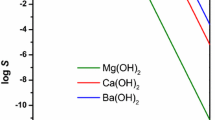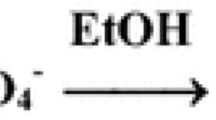Summary
A study of the factors influencing the stability of solutions of hydrogen sulphide in acetone has been made. The presence of small amounts of acid, and less significantly, water is shown to be detrimental; stable solutions are obtained when the dry acid-free gas is absorbed in dry acetone.
Some advantages of such a solution are that it contains a relatively high concentration of H2S (0.5–0.6M), that it is completely miscible with water and that the acetone is easily removed by volatilisation when the reagent is used with aqueous systems.
The reagent is recommended in place of gaseous hydrogen sulphide for the precipitation of the sulphides of the Copper-Tin Group metals in semimicro qualitative analysis, where its application makes it preferable to any technique involving the use of H2S gas.
A new procedure for obtaining the optimum range of acid concentration for the complete precipitation of the Copper-Tin Group sulphides is described and related to the use of the acetone-H2S reagent.
Details are given for the preparation, storage, and analysis of the reagent.
Zusammenfassung
Die Stabilitätsbedingungen acetonischer Schwefelwasserstoff-Lösungen wurden untersucht. Kleine Mengen Säure wirken, wie gezeigt werden konnte, stabilitätsmindernd; ebenso — wenn auch weniger deutlich — die Gegenwart von Wasser. Beständige Lösungen erhält man durch Einleiten trockenen, säurefreien Gases in trockenes Aceton.
Vorteile einer solchen Lösung sind ihre relativ hohe Konzentration an H2S (0,5- bis 0,6-m), ihre unbeschränkte Mischbarkeit mit Wasser und die Möglichkeit, das Aceton durch Abdampfen zu entfernen, wenn das Reagens für wäßrige Systeme angewandt wurde. Es wird daher an Stelle gasförmigen Schwefelwasserstoffes zur Fällung der Sulfide der Kupfer-Zinn-Gruppe bei der qualitativen Halbmikroanalyse empfohlen, da es sich für diesen Zweck als überlegen erwiesen hat.
Eine neue Vorgangsweise für die Einstellung der optimalen Säurekonzentration für die vollständige Ausfällung dieser Sulfide mit Hilfe des Aceton-Schwefelwasserstoff-Reagens wird angegeben. Details für dessen Herstellung, Aufbewahrung und analytische Prüfung werden angeführt.
Résumé
On a fait une étude des facteurs influençant la stabilité des solutions d'hydrogène sulfuré dans l'acétone. On montre que la présence de petites quantités d'acide, et avec une importance moindre, celle de l'eau, ont une influence néfaste; on obtient des solutions stables si le gaz sec et exempt d'acide est absorbé par l'acétone sèche.
Parmi les avantages d'une telle solution, on peut citer le fait qu'elle contient une concentration relativement élevée d'H2S (0,5–0,6M), qu'elle est complètement miscible à l'eau et que l'acétone est facilement séparée par volatilisation quand le réactif est utilisé avec des systèmes aqueux.
Le réactif est recommandé à la place de l'hydrogène sulfuré gazeux pour la précipitation des sulfures des métaux du groupe étain-cuivre en analyse semimicroqualitative, oú son application le rend préférable aux techniques qui emploient H2S gazeux.
On décrit un nouveau procédé pour obtenir le domaine maximum de concentration pour la précipitation complète des sulfures du groupe cuivreétain par emploi du réactif acétonique à l'hydrogène sulfuré.
On donne des détails pour la préparation, le stockage et l'analyse du réactif.
Similar content being viewed by others
References
Midlands Association for Qualitative Analysis. “Semimicro Qualitative Inorganic Analysis, Advanced Tables”, 5th Edition. Birmingham: 1959.
M. Péronnet andR. H. Remy, J. pharm. chim.,30, 170 (1939); Analyst64, 911 (1939) (Abstracted).
British Standards Institution, B. S. 509: 1957. “Acetone”.
W. M. Dowson, Mikrochim. Acta [Wien],1959, 841.
Author information
Authors and Affiliations
Additional information
On the occasion of the hundredth return ofFriedrich Emich's, birthday.
Part XV: Mikrochim Acta [Wien]1960, 366.
I am indebted to Dr.John Majer for carrying out the Chromatographic work, and to ProfessorRonald Belcher for his interest in and support for this study.
Rights and permissions
About this article
Cite this article
Stephen, W.I. Studies in qualitative inorganic analysis. Part XVI. Mikrochim Acta 48, 927–934 (1960). https://doi.org/10.1007/BF01216082
Received:
Issue Date:
DOI: https://doi.org/10.1007/BF01216082




